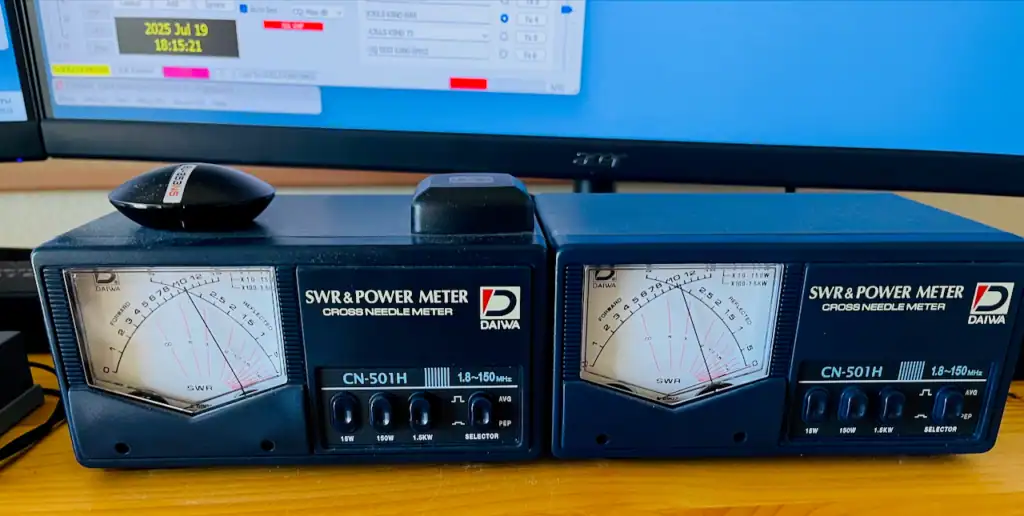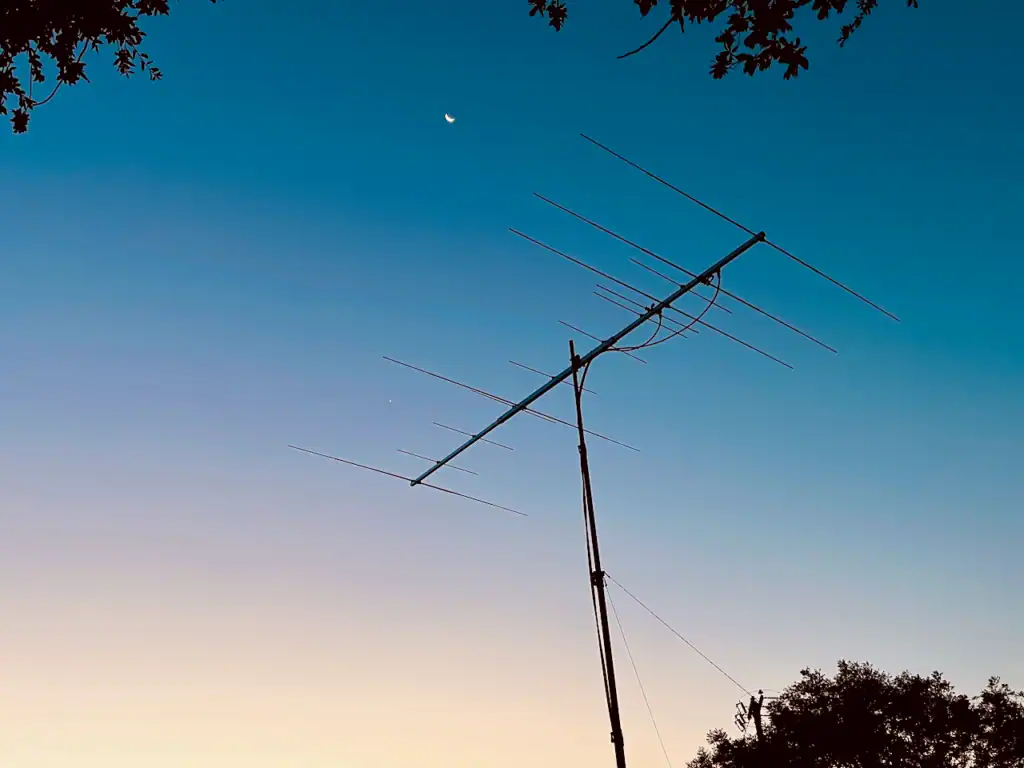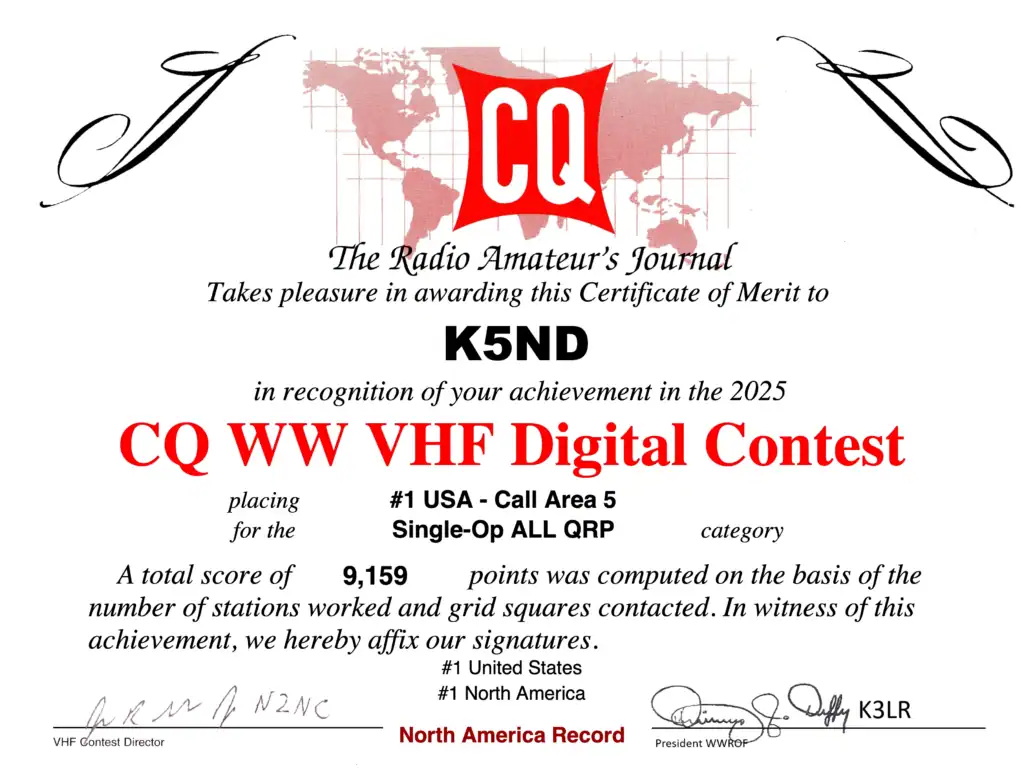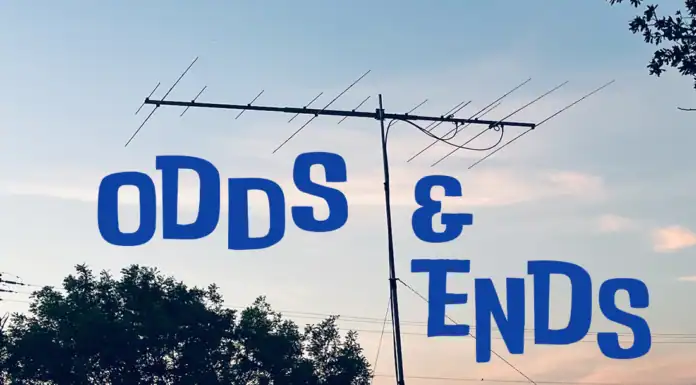For the last several VHF contests, I’ve operated single operator portable or hilltopper from EM01 near Hico, TX. I actually “worked from home” for this CQ VHF contest! Not only that, but I posted a fairly decent score running in the new QRP category with 10 watts.
Hilltopper vs Single Operator QRP
The rule changes for the 2025 CQ VHF contest increased the hilltopper category from 10 watts to 100 watts. It also added a single operator QRP category. Additionally, the contest start time changed from 1 PM to 7 AM Central Time. While the hilltopper could be any six hours, I felt that trying things from home as QRP would be more appealing. After all, it’s fun to work some amazing DX with only 10 watts. Of course, it can be mighty frustrating as well.
Working from Home QRP Station
Another benefit of working from home is that operating two rigs and using my better home antennas is much easier. I used an Icom IC-746Pro for 2 meters along with an Icom IC-9100 for 6 meters. The receivers for both setups use Airspy SDRs and Antennas-Amplifiers LNAs. The antennas include a 5-element 6-meter Yagi and a 9-element 2-meter Yagi on a common boom mounted on a 25-foot push-up mast. The downside is that I have to run down the stairs and outside to hand rotate the mast. It’s actually much easier when running portable.

On the computer side, I used N3FJP’s VHF Contest Logger and JT-Alert to route the QSOs from the two instances of WSJT-X Improved.
CQ VHF 2025 Digital Contest Results
The results surprised me, as conditions were excellent on Saturday morning, reasonably good in the afternoon, with lots of one-and-done in the evening. I also picked up a couple of QSOs and one new grid on Sunday morning before the contest closed at 7 AM Central.
My score came in at 9,432 with 100 QSOs and 60 grids on 6 meters and 16 QSOs and 12 grids on 2 meters. When the contest started, I thought I’d be happy with perhaps a score of 3,000. It worked out much better than I expected.
Operating Challenges
When operating portable at 10 watts, I’ve found it’s best to call CQ. Usually, when I call someone, they either don’t hear me or I’m way down the answering queue in WSJT-X. What I failed to realize is that I’m calling CQ with a grid of EM01, which everyone in the contest needs and can typically only get from my portable operation. That doesn’t work when operating from EM12.
It didn’t take me long to realize that conundrum. So, I spent most of the contest doing search and pounce. When I did call CQ, it was generally to a dead band to see if anyone would come back. Anyone operating QRP in any contest will tell you that patience and persistence are needed, in spades. That’s what happened in my “work from home” adventure. I also spent nearly every minute in the operating chair. That ran from the 7 AM start to about 10 PM, when the band was dead. I was also up at 5:30 AM until the close at 7 AM.
I did have several QSOs that didn’t end successfully. That was mainly because I lost the other station in the middle of the QSO. I always reported RRR on my QSOs and repeated that when I didn’t get a 73. I’m sure I lost a few QSOs, and the log checking report will probably say I should have logged them. Oh well.
I did get a few QSOs from outside the contest. That’s where I called a station, they responded with a signal report, I responded with an R, and they kept sending a signal report. For those, I used the WSJT-X feature of right-clicking on FT8, which switches to signal reports from contest mode.
That worked in most cases. However, one station gave me a -19 report, and no matter how I responded, including moving to their calling frequency, they continued to transmit that -19 signal report. I just looked it up in the ALL.txt file. They called me an amazing 39 times with that same -19 signal report. During those 10 minutes, I tried to move on several times, but they kept calling. Even with that, we did not complete a QSO.
Working from Home — Sweet Home
Well, it was nice not to drive for a couple of hours, set up the antennas, and then sit in the back of the car operating for hours at a time. I had air conditioning, the nearby fridge and bathroom, plus my wife made me some popcorn late at night. This could work except for that great EM01 grid location. We will see what I do for the next contest in September.
Thanks, everyone, for the QSOs and grids.

The results are in, and I managed to win this category. Of course, most operators choose to avoid the frustration of operating with only 10 watts.







